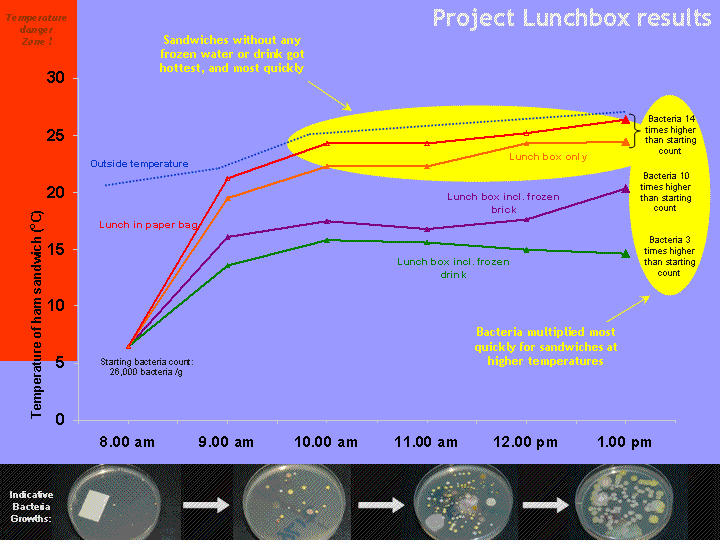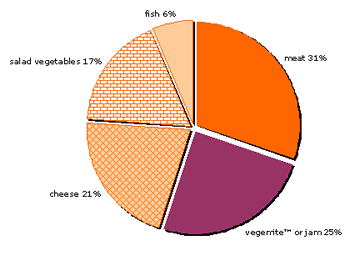- Print this page
- Download as PDF
- Share this page
How to best keep safe the lunches that children take to school is an important question.
Food poisoning is never fun, and toddlers and young children are more at risk because their bodies and natural immune defences are not fully developed.
There is a risk of getting sick if lunches aren’t kept at safe temperatures.
Parents and caregivers can help protect kids by following some simple tips to keep lunch boxes safe. See Kids lunch boxes.
Lunch box survey and experiment – 2023
In 2023 we repeated an online survey to find out if the type of foods children take to school had changed. The survey showed sandwiches continued to be the most popular choice, followed by cut fruit and pasta.
We already knew from the 2009 study that keeping sandwiches cool helped to slow bacterial growth. For the latest experiment, we extended the data to include cut fruit, using watermelon.
Key findings included:
- lunches with ice bricks were between 6°C and 10°C cooler than those without
- the higher the temperature, the more organisms grew
- bacteria in cut watermelon, without an ice brick to keep it cool, were 13 times higher by 2pm.
Read the full report on the survey and experiment (PDF, 285 KB).
Lunch box experiment – 2009
In 2009, the Food Authority’s scientists investigated lunch box safety by:
- testing just how warm lunch boxes get on a warm summer day, with or without ice bricks and frozen drinks
- doing surveys of the sort of foods that children actually take to school.
Lunch temperatures
Just like parents across NSW do every school morning, our scientists made up a range of sandwiches. They then packed them into identical lunch boxes.
They made sure some boxes had a "temperature control device", which is just a fancy term our microbiologists use for a frozen drink or popper or ice brick!
Our scientists also used lunch boxes that didn’t have poppers or ice blocks, while some sandwiches went into nothing more elaborate than a brown paper bag. No temperature control device there!
This way they could compare all 3 to find which was best at keeping food cold.
Time and temperature are important factors for bacterial growth. Kid’s lunches can sit in school bags for up to 5 hours from when the food is prepared to when it’s eaten at lunch.
We all know kids often leave their school bags outside the class room, so we left our test lunches outside in a shady spot on a day when the temperature reached 25oC.
One of the Food Authority’s foodborne illness investigators took careful temperature readings each hour for 5 hours. These were then plotted on a graph, which you’ll find below.
Our science team then sent all the sandwiches off to the lab to see how many food germs were growing.
Lab findings

Our graph clearly shows how the sandwiches in the paper bag were up to 12oC warmer than the lunch box with a frozen drink. The lunch box with an ice block did pretty well, while the lunch box without a frozen drink, popper or ice brick wasn’t much cooler than the paper bag.
You’ll notice there were bacteria in the sandwiches first thing in the morning, after they were freshly made. There’s no need to worry, as nearly all food has some bacteria present and is still safe to eat.
In fact most bacteria are harmless. It’s only when certain types of bacteria grow and multiply that we can become sick.
You’ll see at the end of the experiment there were lots more bacteria in the sandwiches in the paper bag and lunch box without a frozen drink, popper or ice brick than in the lunch boxes with the frozen drink, ice brick or popper.
What can we learn from all this measuring?
Simple! The warmer food is, and the longer it stays warm, the more bacteria grow. If there are disease causing bacteria present they might grow too and that’s bad news as they can potentially make us sick.
Lunch contents
What are kids actually taking to school? In the original experiment in 2006, we also looked at the type of lunch box kids take to school.
We surveyed the lunch boxes of 598 children aged 4 to 12-years-old at schools across Sydney.
We gave teachers a "School Lunch Box Survey" form and asked students if they had a frozen drink or ice block in their lunch box and if they had foods that needed to be kept cool.
We found ...
| Common Lunch box contents | Numbers |
|---|---|
| Number of children with a frozen drink or ice brick: | 68 |
| Number of children with sandwiches for lunch: | 159 |
| Number of children with sandwiches with meat, fish, chicken or cheese: | 92 |
The Authority would like to thank the following schools for participating in our 2006 survey:
- Cambridge Gardens Public School
- Kenthurst Public School
- Lindfield East Public School
In 2009, we did another survey to get more details on what school children take to lunch.
This time, we surveyed 766 young primary school students aged 5 years to 12 years, from 30 classes in 3 schools.
Typical sandwich fillings

Some 74% of the school children had some kind of sandwich. Fillings included:
- meat 30%
- Vegemite™ or jam 25%
- cheese 21%
- salad vegetables 17%
- fish 6%
About 26% had one or more other foods for lunch including:
- dinner leftovers, salad or raw vegetables, pizza, sushi, pasta, noodles, meat pies, sausage rolls, rice, cooked chicken, rice cakes, Sao™ biscuits and so on, either with or without fillings.
Of course, some children had more than one kind of sandwich or food.
Some of these foods remain safe at room temperature, but many of them need to be kept cold to stop food poisoning bugs growing.
Only 29% of the students had an ice brick or cold drink in their lunch box to keep the other food cold.
We noted the maximum temperatures on the days the survey was taken ranged from 21°C to 33°C for Sydney and 21°C to 42°C for Parramatta. All of these temperatures are warm enough for harmful bacteria to grow.
The Authority would like to thank the following schools for participating in our 2009 survey:
- Seven Hills North Public School
- Truscott St Public School, North Ryde
- St Peter Chanel Primary School
